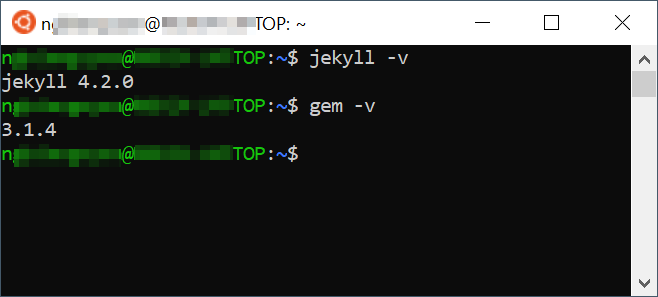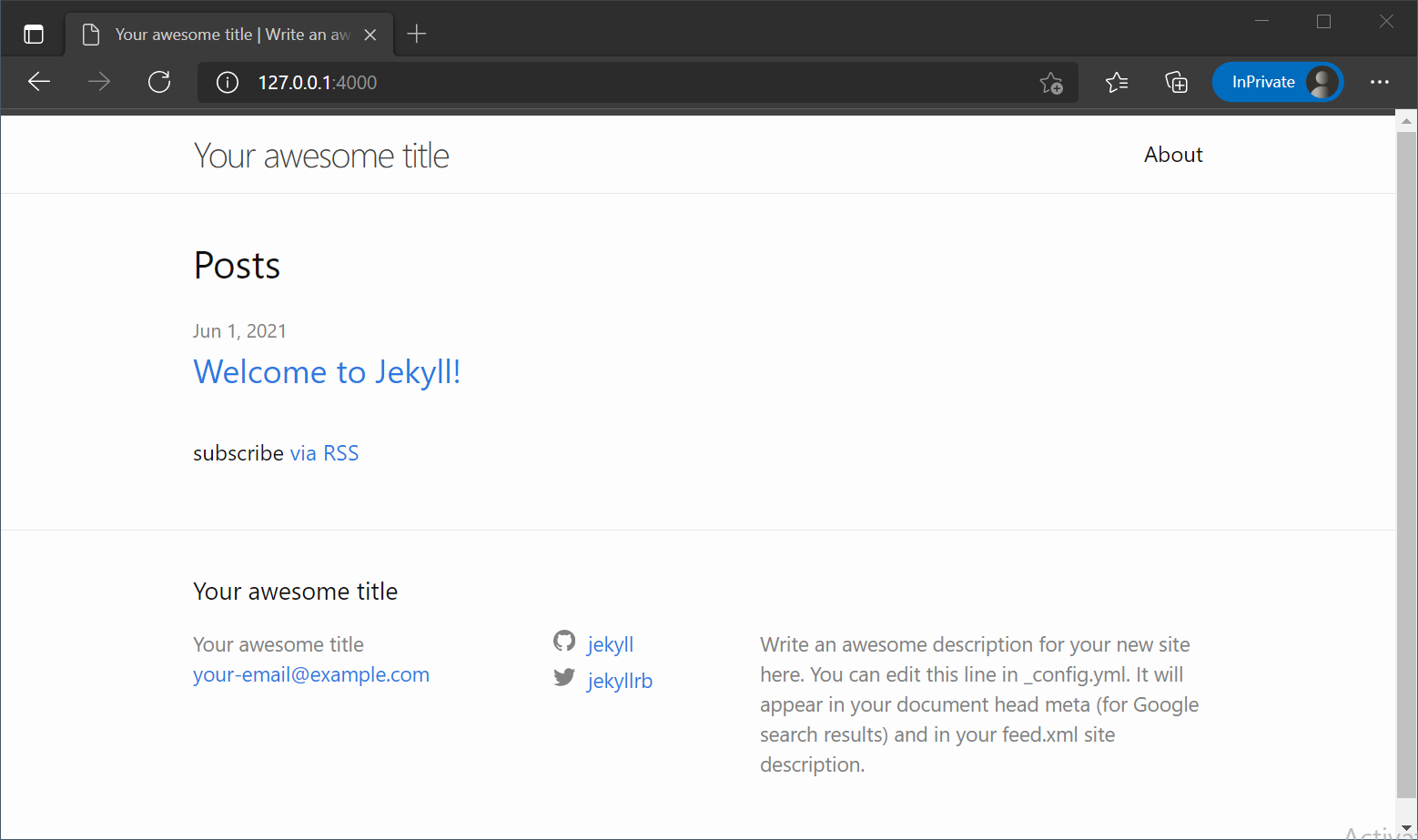Create a GitHub Pages site using Jekyll on Windows Subsystem for Linux (WSL 2)
With the Windows Subsystem for Linux (WSL) we are now able to run a Linux environment directly on Windows 10. I was able to successfully create a GitHub Pages site with Jekyll on WSL 2.
The following are steps I have followed and done.
Step 1: Install WSL 2 (Windows Subsystem for Linux) on Windows 10
I installed WSL 2 on Windows 10 following 6 manual installation steps from Windows Subsystem for Linux Installation Guide for Windows 10
At the final step (step 6) in the installation guide, I selected Ubuntu 20.04 LTS
I did not install Windows Terminal. You can do that if you want.
Step 2: Install Jekyll on Unbuntu
Launch Ubuntu terminal, and follow installation steps from Install Jekyll on Ubuntu
Now we need to confirm that Jekyll and prerequisites are installed on Ubuntu by outputting the version of Jekyll and Gem on Ubuntu terminal. To do this, run the commands on Ubuntu terminal:
$ jekyll -v
and
$ gem -v
You should see something similar to mine

Step 3: Creating a GitHub Pages site with Jekyll
-
Open Ubuntu terminal
-
Navigate to the location where you want to store your site’s source files.
To access to the Windows file system from Ubuntu terminal, you need to use
/mnt/<drive letter>/. Example usage would becd /mnt/cto access thec:\drive.I store my site files on
d:\sites, so I navigate to that folder (remember to change the path if yours is different than mine). Run the command:$ cd /mnt/d/sites -
To create a new Jekyll site under the folder
jekyll-new-site-using-wsl2, use the commandjekyll new <path>:$ jekyll new jekyll-new-site-using-wsl2You should see a message about new site created

-
Open the
Gemfilethat Jekyll created under the folderjekyll-new-site-using-wsl2with Vim on Ubuntu terminal or any your favorite text/code editor on Windows such as Notepad++ or Visual CodeContent of the Gemfile before editing
source "https://rubygems.org" # Hello! This is where you manage which Jekyll version is used to run. # When you want to use a different version, change it below, save the # file and run `bundle install`. Run Jekyll with `bundle exec`, like so: # # bundle exec jekyll serve # # This will help ensure the proper Jekyll version is running. # Happy Jekylling! gem "jekyll", "~> 4.2.0" # This is the default theme for new Jekyll sites. You may change this to anything you like. gem "minima", "~> 2.5" # If you want to use GitHub Pages, remove the "gem "jekyll"" above and # uncomment the line below. To upgrade, run `bundle update github-pages`. # gem "github-pages", group: :jekyll_plugins # If you have any plugins, put them here! group :jekyll_plugins do gem "jekyll-feed", "~> 0.12" end # Windows and JRuby does not include zoneinfo files, so bundle the tzinfo-data gem # and associated library. platforms :mingw, :x64_mingw, :mswin, :jruby do gem "tzinfo", "~> 1.2" gem "tzinfo-data" end # Performance-booster for watching directories on Windows gem "wdm", "~> 0.1.1", :platforms => [:mingw, :x64_mingw, :mswin]-
Add
"#"to the beginning of the line that starts withgem "jekyll"to comment out this line. -
Add the
github-pages gemby removing#at the begining the line starting with# gem "github-pages"to uncommnent this line.
Content of the Gemfile after editing in 5 & 6
source "https://rubygems.org" # Hello! This is where you manage which Jekyll version is used to run. # When you want to use a different version, change it below, save the # file and run `bundle install`. Run Jekyll with `bundle exec`, like so: # # bundle exec jekyll serve # # This will help ensure the proper Jekyll version is running. # Happy Jekylling! # gem "jekyll", "~> 4.2.0" # This is the default theme for new Jekyll sites. You may change this to anything you like. gem "minima", "~> 2.5" # If you want to use GitHub Pages, remove the "gem "jekyll"" above and # uncomment the line below. To upgrade, run `bundle update github-pages`. gem "github-pages", group: :jekyll_plugins # If you have any plugins, put them here! group :jekyll_plugins do gem "jekyll-feed", "~> 0.12" end # Windows and JRuby does not include zoneinfo files, so bundle the tzinfo-data gem # and associated library. platforms :mingw, :x64_mingw, :mswin, :jruby do gem "tzinfo", "~> 1.2" gem "tzinfo-data" end # Performance-booster for watching directories on Windows gem "wdm", "~> 0.1.1", :platforms => [:mingw, :x64_mingw, :mswin]-
Save and close the Gemfile.
-
From the Ubuntu terminal, make sure your current folder is
/mnt/d/sites/jekyll-new-site-using-wsl2(if not, run commandcd /mnt/d/sites/jekyll-new-site-using-wsl2to navigate to that folder), run the command
$ bundle update -
Step 4: Testing your GitHub Pages site locally with Jekyll
-
Continue on Ubuntu terminal from Step 3.8, your current working folder should be
/mnt/d/sites/jekyll-new-site-using-wsl2(if not, run commandcd /mnt/d/sites/jekyll-new-site-using-wsl2to navigate to that folder) -
Run command
$ bundle install -
Run your Jekyll site locally, using command
$ bundle exec jekyll serveYou should see output similar to below screenshot

-
Open your web browser to http://127.0.0.1:4000

Awesome! You run Ubuntu natively on Windows.
Happy using Windows Subsystem for Linux!
💬 Comments
Post a comment on GitHub